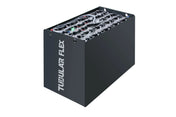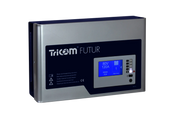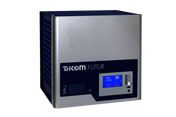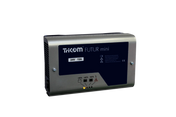What exactly is sulfation?
During each discharge, fine lead sulfate crystals form on the lead plates of a lead-acid battery. Normally, these dissolve completely during charging. Problems arise when these soft particles clump together to form large, hard crystals.
These hardened structures cannot be fully reversed during charging. The forklift battery charges incompletely, loses capacity, and becomes more sluggish. The longer this condition persists, the more the deposits harden.
How quickly does harmful sulfation occur?
Fine crystal formation begins immediately with every discharge – this is normal. It becomes critical over time and with improper charging behavior.
- After a few hours in the deep discharge range, crystal enlargement begins.
- After 24–48 hours without charging, the crystal size measurably increases.
- After 8 days, the crystal size can increase from approximately 1 μm to around 5 μm.
- After 3–5 months, hard, coarse crystals of 10 μm and more form – these are hardly dissolved anymore.
Forklift batteries that are not charged in the evening are therefore particularly at risk.
Why does sulfation occur – and what are the triggers?
Incomplete loading
The main reason: The battery is not fully charged. As a result, residual sulfate remains permanently and continues to increase.
Deep discharge and delayed recharging
Sulfate formation accelerates below 40% state of charge (SoC). It becomes massive during deep discharge , i.e., below 20%. If the battery then sits idle for several hours or days, the crystals harden.
Even a few days of inactivity have a negative impact.
If a discharged battery is not charged for two to three days, visible crystal growth begins. After a week, hard crystals form.
Low electrolyte level
Exposed slabs sulfate rapidly – usually irreversibly. Even a few millimeters of missing water are enough.
Temperature problems
High temperatures above 35–40°C accelerate crystal formation. Cold temperatures are also critical: below 10°C, a forklift battery should not be charged, as the internal resistance increases and the battery charges incompletely.
Acid stratification
Heavier acid sinks to the bottom, while a less concentrated acid forms at the top. The plates at the bottom become overloaded, while those at the top sulfate. This is a typical problem with large traction batteries that lack circulation.
Multi-shift operation (special case forklifts)
In practice, batteries are often topped up rather than fully charged and then deeply discharged. This pattern is the ideal breeding ground for sulfation.
How can sulfation be reliably detected?
Typical symptoms
The most common signs in everyday life:
- Shorter duration
- Loading times are getting longer
- Voltage drop under load
- Different cell voltages
- Increased internal resistance
Critical cell voltages
Harmful crystal formation begins below 2.07 V/cell. For typical battery voltages, this means:
- 24V battery → critical below 24.84V
- 48V battery → critical below 49.68V
- 80V battery → critical below 78.66V
Early detection – when does it become serious?
| Condition | Symptoms | measure |
|---|---|---|
| Slight sulfation | Capacity loss 10–20%, slightly longer charging time | Pulse charge, full charge, check water level |
| Medium sulfate | 20–40% less battery life, cells drift apart | Desulfurization device, EIS measurement, density check |
| Severe sulfation | Significant power drop, large voltage differences | Professional regeneration |
| Irreversible sulfation | Cells break under load, high temperature, mud at the bottom | Battery replacement |
What effect does sulfation have in practice?
Capacity loss
Hardened crystals reduce the active surface area. The battery stores less energy and discharges faster.
Increased internal resistance
The current flow becomes sluggish. The forklift feels "weak," even though the charge level appears high.
Cell damage and sludge
Sulfate detaches, sinks to the bottom, and can cause short circuits. This often leads to the total failure of a cell.
Permanent damage
At a certain point, crystals can no longer be dissolved. Even a high-quality charger won't help then.
How can sulfation be prevented?
1. Charging correctly – Flotation vs. Pulse charging
Flotation charging: Continuous trickle charging at approximately 2.23–2.30 V/cell. Keeps the battery stable and prevents self-discharge.
Pulse charging: Short voltage pulses that break down soft sulfates. Very effective for prevention and in cases of mild sulfation.
2. Complete charges
Always charge to 100%. Partial charges are the main cause of hard crystals.
3. Avoid deep discharges
You should rarely go below 40–50% SoC. Anything below 20% is extremely harmful.
4. Water treatment
Use only distilled water. Always fill after loading. Even a level that is 5–10 mm too low can cause plate damage.
5. Temperature control
- Do not charge below 10°C.
- Optimal: 25–30°C.
- Critical above 40°C.
- Dangerous above 55°C.
6. Check acid density regularly
Ideal: 1.29 kg/l at 30°C. Deviations reliably indicate early problems.
7. Prevent acid stratification
Regular full loads and occasional equalization loads are mandatory. Without them, stratification often begins unnoticed.
Acid stratification – a problem in itself
In large forklift batteries, heavy acid collects at the bottom. A thinner liquid forms at the top – the plates at the bottom overheat, while those at the top sulfate. The battery ages unevenly.
Electrolyte circulation or mammoth pumps provide a remedy and significantly extend the service life.
Desulfurization – what really works?
Smart chargers
Good devices use PWM pulses. They dissolve soft sulfates, but not hard crystals. The process usually takes 2–7 days.
Chemical desulfurization (EDTA)
EDTA can partially bind sulfate. Typical dosage: approx. 4 g per cell . It is more effective in new batteries, but only to a limited extent in neglected ones.
Electrolyte circulation
Air circulation homogenizes the acid. This prevents stratification and improves charging efficiency.
Professional regeneration
Specialized companies work with frequency pulses, pH adjustment, and EIS diagnostics. This often allows them to recover 60–80% of the original capacity .
Diagnosis – how EIS detects sulfation early
EIS measures the frequency-dependent internal resistance. Any type of sulfation, aging, or stratification alters the impedance spectrum. This allows problems to be detected weeks or months before they become noticeable in everyday use.
For larger fleets, EIS is the most reliable diagnostic method.
Economic efficiency – when to regenerate, when to replace.
Regeneration is worthwhile when…
- the battery is younger than 6-7 years,
- the cells are still stable,
- the capacity is between 40–80%,
- the internal resistance is still moderately increased.
Exchange is more economical if…
- Cells show signs of short circuits
- heavy mud is present
- individual cells immediately collapse under load,
- the battery is over 8-10 years old.
Cost orientation
- Regeneration: approx. €300-900
- New forklift battery: €3,000–€6,000+
Maintenance intervals – clear and practical
Daily
- Check water level
- Check cables & poles
- Check battery temperature
Weekly
- Measure cell voltage in resting state
- Visual inspection for layering
Monthly
- Measure electrolyte density
- Short active discharge
Yearly
- EIS analysis
- Measure insulation resistance
- Professional examination
Conclusion
Sulfation develops quickly, often goes unnoticed for a long time, and in the worst case can cost several thousand euros. However, the problem can largely be avoided with complete charging cycles, proper water treatment , good temperature control, and regular diagnostics.
If sulfation has already occurred, intelligent chargers, chemical additives, circulation or professional regeneration can help – often at a significantly lower cost than buying a new one.







